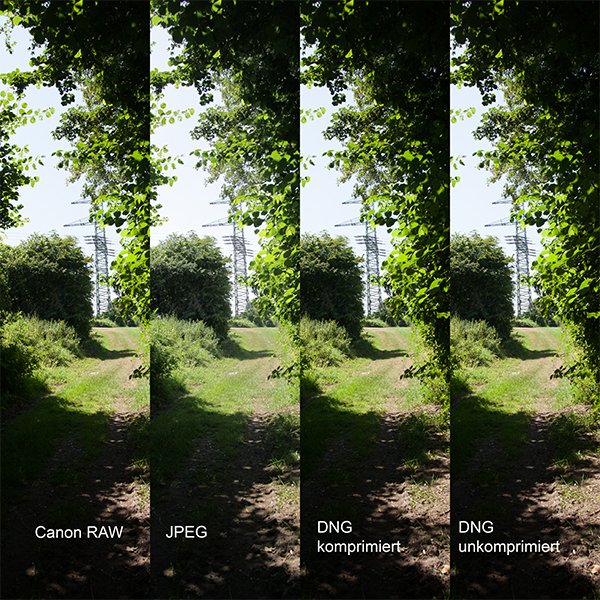RAW,JPEG or even DNG
There are enough discussions among photographers about the file format to use, choosing between JPEG or RAW format. Adding Adobe DNG format to the discussion it sort of turns it into a religios war. So what is the best format, RAW,JPEG or even DNG
The formats
JPEG is a file format for digital images, which uses a lossy compression. The lossy compression is the main fact for not being suitable to extended image processiong, because every time you save an jpeg image quality reduction gains. The other problem is that JPEG is an 8-bit file format, which reduces the range of colors and the dynamic of the image.
RAW gives you a lot more capabilities, beacuse depending on the manufacture you’ll get 10-14 for every channel. On the other hand, there is no one file format raw, because every manufacture makes his own raw format. Even the same file extension does not garantuee the same format, or within a series like .cr2 for Canon cameras and .nef for Nikon doesn’t necessarily mean, that you cope with the same raw format. Everybody buying a new camera, which is not supported e.g. by Lightroom, knows what i’m talking about.
And now what si this alla bout the DNG format? DNG is Adobe attempt to establish a standardized RAW data format for all manufactures. Mybe there was hidden agenda not to update the own software products like Lightroom and Photoshop every time a new camera modell is published. Some manufactures like Leica and Pentax got involved in the DNG format, so their cameras write DNG or at least offer an option to write DNG.
The comparism
Ok lets compare the 3 formats
 Due to the small image size i compared the picture in 200% view
Due to the small image size i compared the picture in 200% view

I think this makes the difference really clear. The order is RAW,JPEG,compressed and uncompressed DNG. The raw file size is 26.479 KB, JPEG 787 KB, DNG compresses 9405 KB and uncompressed 21214KB.
The qualitiy of the compressed DNG comapared to the raw format is astonishing good, reducing the file size to almost 1/3 of the original raw file.
I think the decision between JPEG and RAW is clearly pro RAW. And if you take a look at the reserves you gain by taking pictures in RAW format and the image processing by Lightroom since process version 2012, there should be no doubt about it.
But what about DNG?
Where is the DNG format to be sorted in?. The comparism above shows that the difference between uncompressed and comrepssed DNG is negligible. Taking into consideration the file size you go to compressed DNG format.
A further pro argument using DNG is the lack of sidecar files, because EXIF metadata and developement information are stored in the DNG file, so backups are easier. To me this argument is not convincing. In the article [post id=73]Lightroom and XMP[/post] files i stated, that the XMP sidecar files are usually not necessary. But even the DNG file only contains the last development status.
In some older articles the DNG format is preferred for laptop users. But since Lightroom version 5 this argument is not available due to the smart previews. Later are DNG files, but you stay tuned to raw file format for your picture taking.
Conclusion
You habe to decide for yourself, but to me DNG files are no alternative, mainly because i add another step in the workflow to convert the raw files to DNG, which costs time. Since the other arguments (no XMP sidecar, easier backup) do not prove i stay with raw files.
Since the advantage of file size reduction is not playing the first role in times of increasing hdd capacities, i use DNG files for timelapse photography. A complete sequence may contain somewhre between 400-1500 shots, so reducing space in this special case is an argument 😉 Another is that i dont need the last qualitiy since timelapse sequences are converted to 1920x1080px videos.
Whta are you doing, do you use DNG or are you stickes to RAW format? Wie macht ihr das, benutzt ihr DNG oder fotografiert ihr weiterhin in RAW? I would appreciate your comments/suggestions oder any questions.
ciao tuxoche




Raw gives you a lot more control and options in editing. But you need to know your stuffs though. Quite a number of times I ended up with worse than what the JPG offers.
RAW and nothing else.
Photographers have always been developing their photos so why stop now. I would never let my style be controlled by some setting a Chinese dude have preinstalled in my camera.
Hi Michael,
agree i use RAW and only later convert to DNG for timelapse images